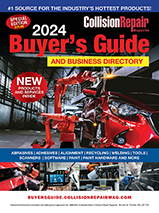Toronto, Ontario – Pushing the boundaries of rechargeable lithium-ion batteries is hard to do when you lack a proper understanding of EV batteries–not to mention a failure to initiate proper repurposing and safety measures. Just ask Joseph Chung and his partners at Call2Recycle.
A featured speaker at Collision Repair magazine’s EV Repair Tour, supported by Fix Network, Chung delivered a “battery 101” presentation, where he outlined how Canada-based not-for-profit Call2Recycle helps both automobile industry workers and civilians in the process of safely recovering, repurposing, and recycling their rechargeable batteries. He also discussed the importance of diverting these batteries from being left unattended either on private lots or in landfills.
During his presentation, Chung noted that when it comes to rechargeable batteries–and EV batteries, especially–recovery, repurposing, and recycling is critical from both an environmental and safety standpoint. From an environmental standpoint, Chung discussed the long-term importance of creating a “circular economy” of resources, since the lithium and precious metals found in rechargeable batteries are so often finite, and recovering them can help to establish a continuous cycle of battery production.
In regard to immediate industry safety, Chung emphasized that “identifying [any potential] damage is critical for safety” and for the recovery process. Before a battery can be recovered, repurposed, or recycled, potential damage must be recorded–further highlighting the importance of a facility’s documentation processes in the modern market.
Chung offered some helpful identifiers such as looking for any dents in the battery shell, gas leaks, or evidence of smoke.
Identifying any potential damage is crucial since defects to rechargeable batteries can create a “cascading effect” wherein, “a little fender bender [to an EV] could have damaged a couple of the cells within the battery module.”
On this note, Chung shared an incident in New Jersey in July 2023 in which: “one defective battery went unnoticed” and caused an entire facility to go up in flames, resulting in over one million dollars in clean-up damages alone.
However, Chung noted that it’s not all “doom and gloom” when it comes to rechargeable battery safety and recovery “if you take precautions.” Such precautions can include isolating potentially damaged or defective batteries from other vehicles, not handling a battery or EV vehicle until damage has been identified and having an EV-specific first aid kit in automotive shops.
Once proper measures have been put in place and any damage has been identified, Chung finished his presentation by outlining how Call2Recycle is Transport Canada certified to pick up and transport hazardous materials and can take steps to provide “safe logistical transport and removal.” The organization supports all provinces that are currently regulated with extended producer responsibility this includes: Saskatchewan, Manitoba, Ontario, Quebec and P.E.I. with Nova Scotia fast-tracking for regulation launches in 2024 and Alberta and the territories by 2026.
When it comes to rechargeable batteries, “what looks to [be fine] to the naked eye can be very misleading,” but by reaching out to Call2Recycle at evbatteryrecovery.ca, any civilian or business can input vehicle and battery details of concern and can work to facilitate the dialogue so necessary in continuing to carry the rechargeable battery forwards into the future.
Collision Repair magazine’s EV Repair Tour will stop in:





























































